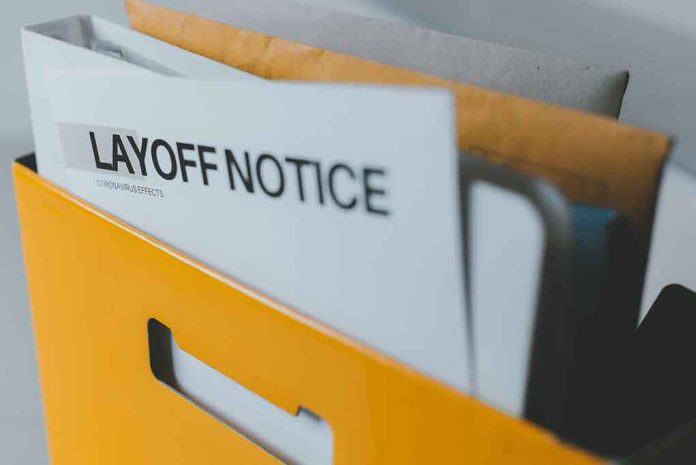
The U.S. private sector just suffered its first job loss in over two years, shedding 33,000 positions in June while economists had expected a gain of nearly 100,000 jobs—signaling a potentially troubling shift in the labor market under President Trump’s watch.
Key Takeaways
- U.S. private payrolls unexpectedly fell by 33,000 jobs in June, the first decline since March 2023, missing economists’ expectations of a 95,000-100,000 increase.
- Job losses concentrated in professional services, education, health services, and financial sectors, while leisure, hospitality, manufacturing, and construction showed modest gains.
- Smaller businesses were hit hardest by job losses, while larger firms managed to maintain some payroll growth.
- Despite job losses, employee pay continued to rise with annual pay up 4.4% for job stayers and 6.8% for job changers.
- Regional disparities emerged with the Midwest and Western U.S. experiencing the largest job contractions while the Southern U.S. continued to see job growth.
Unexpected Job Losses Shock Economists
The private sector unexpectedly shed 33,000 jobs in June, marking the first decline since March 2023 and dramatically missing economists’ predictions of nearly 100,000 new jobs. This surprising contraction in employment comes as a sobering indicator that the labor market may be weakening despite President Trump’s economic policies. The decline is particularly concerning as it represents a stark departure from the positive job growth that has characterized the post-pandemic recovery period. Sectors that previously showed resilience are now displaying signs of vulnerability, with professional services, education, health services, and financial activities leading the downturn.
“Though layoffs continue to be rare, a hesitancy to hire and a reluctance to replace departing workers led to job losses last month,” said Nela Richardson, ADP’s chief economist.
Regional and Business Size Disparities
The job losses revealed significant geographic and business-size disparities across the country. The Midwest and Western regions of the United States bore the brunt of the employment contraction, while the Southern states managed to maintain positive job growth. This regional variation suggests that economic conditions are not uniform nationwide, with some areas experiencing more severe challenges than others. The uneven distribution of job losses could potentially exacerbate existing regional economic inequalities and create localized pockets of economic distress that may require targeted policy interventions.
“Use ADP only to gauge the big picture. Right now, that picture shows ADP’s private sector employment estimates declining steadily since December. Today’s big drop underscores that decaying trend,” said Carl Weinberg.
Small businesses, already operating with thinner margins and fewer resources, were disproportionately affected by the job losses, while larger corporations demonstrated greater resilience, managing to sustain some level of payroll growth. This disparity highlights the vulnerability of small enterprises to economic fluctuations and may signal deeper structural issues within certain sectors of the economy. The concentration of job losses among smaller firms is particularly concerning given their traditional role as drivers of employment growth and innovation in the American economy.
Mixed Signals Amid Economic Uncertainty
Despite the overall job losses, some sectors showed resilience with modest gains. Leisure and hospitality, manufacturing, and construction industries added jobs, suggesting that consumer spending on services and physical goods production remains relatively stable. Notably, even amid the hiring slowdown, wage growth continued, with job stayers seeing annual pay increases of 4.4% and job changers benefiting from a 6.8% increase, albeit slightly down from the previous month’s 7% growth for job hoppers.
“Without a strong economic driver, hiring may remain measured through the rest of the year,” warned Andrew Challenger, highlighting the cautious approach many businesses are taking in the current economic environment.
Challenging the ADP report’s concerning outlook, President Trump has projected confidence in the economy’s trajectory. “Trillions of Dollars are now being invested into the USA, more than ever before. Likewise, hundreds of Billions of Dollars in Tariffs are filling up the coffers of the Treasury. The Tariff money has already arrived and is setting new records,” said Trump.
Looking Ahead: Government Report and Future Expectations
Economists caution that the ADP report has a historically poor track record in predicting the Bureau of Labor Statistics’ official employment figures, which are set to be released soon. The government’s employment report is expected to show an increase of 105,000 private payrolls and 110,000 overall nonfarm payrolls for June, with the unemployment rate potentially rising to 4.3% from May’s 4.2%. This divergence in expectations highlights the complex and sometimes contradictory signals emerging from different economic indicators, making it challenging for policymakers and businesses to navigate the current economic landscape.
“We are growing our way out of the Sleepy Joe Biden MESS that he and the Democrats left us, and it is happening much faster than anyone thought possible. Our Country will make a fortune this year, more than any of our competitors, but only if the Big, Beautiful Bill is passed!” President Trump continued, as the GOP’s spending bill narrowly passed the Senate and has moved to the House.
While planned layoffs dropped 49% in June compared to May and second-quarter layoffs were down 50% from the first quarter, planned hiring decreased to just 3,191 in June from 9,683 in May. This suggests that while companies aren’t cutting existing staff at high rates, they’re increasingly hesitant to add new positions, creating a potential stagnation in job market growth that could persist through the remainder of the year unless economic conditions improve significantly.





